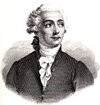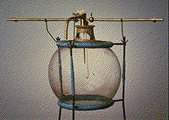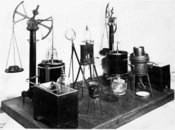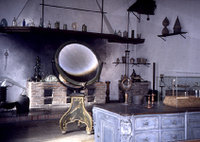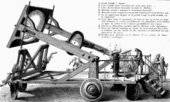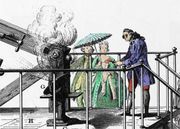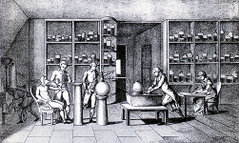Antoine Lavoisier
2007 Schools Wikipedia Selection. Related subjects: Chemists
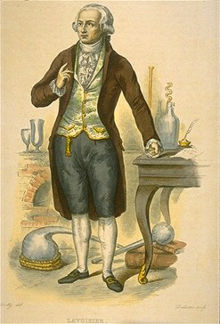 Father of modern chemistry |
|
| Born: | August 26, 1743 Paris, France |
|---|---|
| Died: | May 8, 1794 Paris, France |
| Occupation: | Chemist, economist and nobleman. |
Antoine-Laurent de Lavoisier ( August 26, 1743 – May 8, 1794) the " father of modern chemistry," was a French nobleman prominent in the histories of chemistry, finance, biology, and economics.
He stated the first version of the Law of conservation of mass, co-discovered, recognized and named oxygen (1778) as well as hydrogen, disproved the phlogiston theory, introduced the Metric system, invented the first periodic table including 33 elements, and helped to reform chemical nomenclature. He was also an investor and administrator of the " Ferme Générale," a private tax collection company; chairman of the board of the Discount Bank (later the Banque de France); and a powerful member of a number of other aristocratic administrative councils.
Due to his prominence in the pre-revolutionary government in France, he was beheaded at the height of the French Revolution, instructing his assistant to count the number of words his severed head attempted to mouth.
Early life
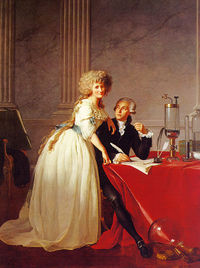
Born to a wealthy family in Paris, Antoine Laurent Lavoisier inherited a large fortune when his mother died. He attended the College Mazarin from 1754 to 1761, studying chemistry, botany, astronomy, and mathematics. His education was filled with the ideals of the French Enlightenment of the time, and he felt fascination for Maquois's dictionary. His devotion and passion for chemistry was largely influenced by Étienne Condillac, a prominent French scholar of the 18th century. His first chemical publication appeared in 1764. In 1767 he worked on a geological survey of Alsace-Lorraine. He was elected a member of the French Academy of Sciences, France's most elite scientific society, at the age of 25 in 1768 for an essay on street lighting and in recognition for his earlier research. In 1769 he worked on the first geological map of France.
In 1771, he married the 13-year-old Marie-Anne Pierrette Paulze, the daughter of a co-owner of the Ferme. With time, she proved to be a scientific colleague to her husband. She translated documents from English for him, including Richard Kirwan's "Essay on Phlogiston" and Joseph Priestley's research. She created many sketches and carved engravings of the laboratory instruments used by Lavoisier and his colleagues. She also edited and published Lavoisier’s memoirs and hosted many parties during which eminent scientists would discuss new chemical theories. As a result of her close work with her husband, it is difficult to separate her individual contributions from his, but it is correctly assumed that much of the work accredited to him bears her fingerprints.
Contributions to chemistry
Background
Beginning in 1775, Lavoisier served in the Royal Gunpowder Administration, where his work led to improvements in the production of gunpowder and the use of agricultural chemistry by designing a new method for preparing saltpeter.
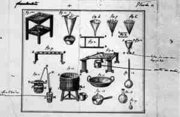
Major works
Some of Lavoisier's most important experiments examined the nature of combustion, or burning. Through these experiments, he demonstrated that burning is a process that involves the combination of a substance with oxygen. He also demonstrated the role of oxygen in metal rusting, as well as its role in animal and plant respiration: working with Pierre-Simon Laplace, Lavoisier conducted experiments that showed that respiration was essentially a slow combustion of organic material using inhaled oxygen. Lavoisier's explanation of combustion replaced the phlogiston theory, which postulates that materials release a substance called phlogiston when they burn.
Research on hydrogen and his role in disproving the phlogiston theory
He also discovered that the flammable air of Henry Cavendish which he termed hydrogen ( Greek for "water-former"), combined with oxygen to produce a dew, as Joseph Priestley had reported, which appeared to be water. Lavoisier's work was partly based on the work of Priestley (he corresponded with Priestley and fellow members of the Lunar Society). However, he tried to take credit for Priestley's discoveries. This tendency to use the results of others without acknowledgment, then draw conclusions of his own, is said to be characteristic of Lavoisier. In "Sur la combustion en général" ("On Combustion in general," 1777) and "Considérations Générales sur la Nature des Acides" ("General Considerations on the Nature of Acids," 1778), he demonstrated that the "air" responsible for combustion was also the source of acidity. In 1779, he named this part of the air "oxygen" (Greek for "acid-former"), and the other "azote" (Greek for "no life"). In "Réflexions sur la Phlogistique" ("Reflections on Phlogiston," 1783), Lavoisier showed the phlogiston theory to be inconsistent.
Pioneer of stoichiometry
Lavoisier's experiments were among the first truly quantitative chemical experiments ever performed; that is, he carefully weighed the reactants and products involved, a crucial step in the advancement of chemistry. He showed that, although matter can change its state in a chemical reaction, the quantity of matter is the same at the end as at the beginning of every chemical reaction. He burnt phosphorus and sulphur in air, and proved that the products weighed more than the original. Nevertheless, the weight gained was lost from the air. These experiments provided evidence for the law of the conservation of matter, or in other words, the law of conservation of mass.
Major works on analytical chemistry and chemical nomenclature
Lavoisier also investigated the composition of water and air, which at the time were considered elements. He discovered the components of water were oxygen and hydrogen, and that air was a mixture of gases - primarily nitrogen and oxygen. With the French chemists Claude-Louis Berthollet, Antoine Fourcroy and Guyton de Morveau, Lavoisier devised a chemical nomenclature, or a system of names describing the structure of chemical compounds. He described it in Méthode de nomenclature chimique (Method of Chemical Nomenclature, 1787). Their system facilitated communication of discoveries between chemists of different backgrounds and is still largely in use today, including names such as sulfuric acid, sulfates, and sulfites.
His Traité Élémentaire de Chimie (Elementary Treatise of Chemistry, 1789, translated into English by Robert Kerr) is considered to be the first modern chemical textbook, and presented a unified view of new theories of chemistry, contained a clear statement of the Law of Conservation of Mass, and denied the existence of phlogiston. Also, Lavoisier clarified the concept of an element as a simple substance that could not be broken down by any known method of chemical analysis, and he devised a theory of the formation of chemical compounds from elements.
In addition, it contained a list of elements, or substances that could not be broken down further, which included oxygen, nitrogen, hydrogen, phosphorus, mercury, zinc, and sulphur. It also forms the basis for the modern list of elements. His list, however, also included light and caloric, which he believed to be material substances. While many leading chemists of the time refused to believe Lavoisier's new revelations, the Elementary Treatise was written well enough to convince the younger generation.
Aftermath
Lavoisier's fundamental contributions to chemistry were a result of a conscious effort to fit all experiments into the framework of a single theory. He established the consistent use of chemical balance, used oxygen to overthrow the phlogiston theory, and developed a new system of chemical nomenclature which held that oxygen was an essential constituent of all acids (which later turned out to be erroneous). Lavoisier also made introductory research on physical chemistry and thermodynamics in joint experiment with Laplace, when he used a calorimeter to estimate the heat evolved per unit of carbon dioxide produced, eventually they found the same ratio for a flame and animals, indicating that animals produced energy by a type of combustion.
He also made remarkable contributions to chemical bonding by stating the radical theory, believing that radicals, which function as a single group in a chemical reaction, would combine with oxygen in reactions. He also introduced the possibility of allotropy in chemical elements when he discovered that diamond is a crystalline form of carbon.
He also updated many chemical concepts, for the first time the modern notion of elements was laid out systematically; the three or four elements of classical chemistry gave way to the modern system, and Lavoisier worked out reactions in chemical equations that respect the conservation of mass (see, for example, the nitrogen cycle).
His contributions are considered the most important in advancing the science of chemistry to the level of what had been achieved in physics and mathematics during 18th century.
Contributions to biology
Lavoisier used a calorimeter to measure heat production as a result of respiration in a guinea pig. The outer shell of the calorimeter was packed with snow, which melted to maintain a constant temperature of 0 °C around an inner shell filled with ice. The guinea pig in the centre of the chamber produced heat which melted the ice. The water which flowed out of the calorimeter was collected and weighed. 1 kg melted ice = 80 kcal heat production by the guinea pig. He concluded, "la respiration est donc une combustion." That is, respiratory gas exchange is a combustion, like that of a candle burning.
Law and politics
Of key significance in Lavoisier's life was his study of law. He received a law degree and was admitted to the bar, but never practiced as a lawyer. He did become interested in French politics, and as a result, he obtained a position as tax collector in the Ferme Générale, a tax farming company, at the age of 26, where he attempted to introduce reforms in the French monetary and taxation system. While in government work, he helped develop the metric system to secure uniformity of weights and measures throughout France.
Execution
As one of 28 French tax collectors and a powerful figure in the unpopular Ferme Générale, Lavoisier was branded a traitor during the Reign of Terror by revolutionists in 1794. He was tried, convicted, and guillotined on the same day in Paris, at the age of 51. Ironically, Lavoisier was one of the few liberals in his position. One of his actions that may have sealed his fate was a contretemps a few years earlier with the young Jean-Paul Marat, who subsequently became a leading revolutionary.
An appeal to spare his life was cut short by the judge: "The Republic has no need of geniuses [or, alternately, "scientists"]." His importance for science was expressed by the mathematician Joseph Louis Lagrange who lamented the beheading by saying: "It took them only an instant to cut off that head, but France may not produce another like it in a century."
One and a half years following his death, Lavoisier was exonerated by the French government. When his private belongings were delivered to his widow, a brief note was included reading "To the widow of Lavoisier, who was falsely convicted".
About a century after his death, a statue of Lavoisier was erected in Paris. It was later discovered that the sculptor had not actually copied Lavoisier's head for the statue, but used a spare head of the Marquis de Condorcet, the Secretary of the Academy of Sciences during Lavoisier's last years. Lack of money prevented alterations being made. The statue was melted down during the Second World War and has never been replaced.
